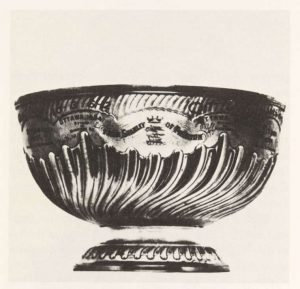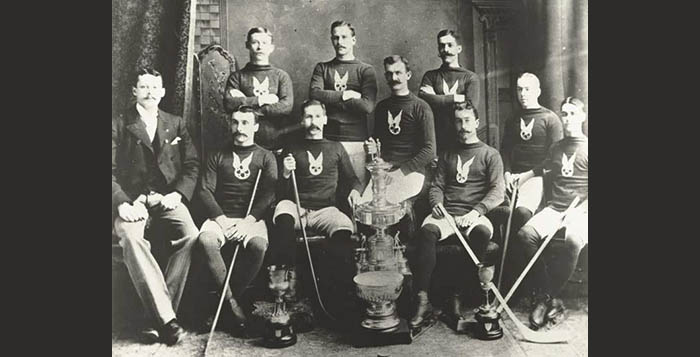This Day in Hockey History – March 22, 1894 – Quest for the Cup
(Image: Montreal Hockey Club, 1893, via Wikimedia Commons)
It quickly became the ultimate prize that every professional hockey player strove for each year. NHL teams continue to define themselves in terms of winning the right to this piece of hardware. However, the annual reward predated the NHL by a quarter of a century.

Premiere Coupe Stanley, via Wikimedia Commons
The quest for the Cup began with Frederick Arthur Stanley, Baron Stanley of Preston, 16th Earl of Derby, the governor general of Canada from 1888 to 1893. Upon watching his first hockey game at the Montreal Winter Carnival on February 4, 1889, according to the Montreal Gazette, he “expressed his great delight with the game of hockey and the expertise of the players.” To promote the sport, in 1892 he paid $48.67 for a gold-lined silver bowl to reward the top Canadian team. Although inscribed as the Dominion Hockey Challenge Cup, the award has taken on the name of its original donor, the Stanley Cup.
The Cup was intended to reward the top challenger, the leader of the Amateur Hockey Association of Canada (AHAC) at the end of the 1892-93 season. Thus, the Montreal Hockey Club (affiliated with Montreal Amateur Athletic Association (MAAA)) received the recognition first. Having won seven of eight games, they ranked first in their five-club league.
Teams first challenged for the Stanley Cup in March 1894 because four AHAC teams finished the season with the same record (5-3-0). Since a tie-breaking system did not exist, the Cup trustees and league governors created a tournament. The Quebec team withdrew, leaving three teams to vie for the championship. As the only remaining team not from Montreal (and thus without “home ice” advantage), the Ottawa Hockey Club (later the Ottawa Senators) was given a pass to the finals. That left the Montreal Hockey Club and the Montreal Victorias to play a preliminary elimination round.
On March 17, 1894, the two Montreal teams played the first Stanley Cup playoff game. The Victoria Rink was crowded that Saturday night, and the audience was “pretty well divided” between the teams. The Gazette noted how water on top of the ice interfered with passing and lifting even as the skating remained fast. “The combination play of the Victoria forwards was excellent, and shot after shot was sent skimming through the water and kept missing the goals by inches.” Thus, Montreal HC scored first, in the first minute of play. The Victorias managed to tie before the session ended and then scored again as the next began. However, Montreal HC responded with two more to win 3-2. The Gazette praised the “rattling, dashing clean game” and bragged that “with truth it may be said that better hockey is played in Montreal than anywhere else.”
Montreal Hockey Club advanced to play Ottawa Hockey Club for the first Stanley Cup final, held on March 22, 1894. Victoria Rink welcomed its largest ever crowd to that point, of about 5,000, with the majority cheering for Montreal. As the Gazette commented, “It was a case of blood being thicker than water.” That crowd was loud and colorful. “There was ‘siss-boom-ah,’ ‘rah-rah-rah’ and several other audible tokens of imbecility and enthusiasm mixed.” The Gazette reporter complained that tin horns “made a much more certain sound, which the acoustic properties of the Victoria rink despatched back in heart-rending reverberations.” However, the view seemed to make up for the noise. “One of the pleasing features of the match was the display of ribbon. Every lady almost in the rink wore the favours of their particular club and never did belted knight in joust or tourney fight harder than the hockey men.”
The ice itself, the Gazette noted, “could not be expected to be good, and the conditions generally could be much improved upon if these great deciding games could be held earlier in the season.” The Globe agreed, “Team play was marred by the softness of the ice. Rough and foul play was frequent, both defences indulging freely in tripping and slashing.” With these conditions, Montreal dominated offensively during the first eight minutes but were effectively blocked by Ottawa’s goalie. Ottawa took charge long enough to score the first goal. Although their goalie stayed strong, he did allow a Montreal goal in before the end of the first half. In the second half, as the Gazette described, “the visitors made great efforts and their attack was splendid” but “Montreal defence seemed impregnable.” Montreal scored twice more to win the final 3-1.
After what the Montreal Gazette termed “perhaps the most brilliant [season] in the history of the game,” the Montreal Hockey Club successfully defended their title, became the first to win the Cup after a contest, and became the first to win the Cup in back-to-back seasons. The Gazette rightfully concluded, “Not only the Canadian championship, but the Governor-General’s cup depended on this match, and Montreal can fly its colors in the face of any hockey breeze that ever blew.” Montreal still holds the record for most Stanley Cup championships.
Additional Sources:
- Brian McFarlane, Brian McFarlane’s History of Hockey (Champaign, Ill.: Sports Publishing Inc., c1997), 5-6.
- https://en.wikipedia.org/wiki/List_of_Stanley_Cup_champions
- https://en.wikipedia.org/wiki/1894_AHAC_season
- http://www.nhl.com/ice/page.htm?id=25065
- https://www.nhl.com/news/stanley-cup-timeline-from-1892-to-today/c-660570
- https://www.thecanadianencyclopedia.ca/en/article/stanley-cup-feature
- https://www.nationalgeographic.org/thisday/mar22/montreal-wins-first-stanley-cup/
- “Montrealers Victorious,” Montreal Gazette, 19 March 1894, p. 8.
- “Montreal the Champion,” Montreal Gazette, 23 March 1894, p. 8.














